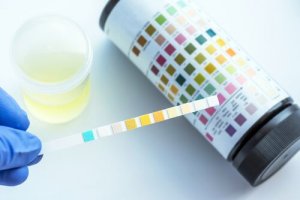What Does a Urinalysis Detect?

Urinalysis is a diagnostic test medical professionals use to detect different types of health disorders. In this analysis, a professional examines the appearance, concentration, and content of urine. The results may suggest the presence of a disease. Then, the medical professional will confirm the diagnosis with other methods.
Also, it’s important to mention that, on its own, a urinalysis doesn’t yield a definitive diagnosis. In fact, a doctor has to interpret the implications of the results. These kinds of tests are carried out to establish the presence of a disorder, but also to prevent or track it.
A urinalysis detects substances that the body is unable to retain or that it must eliminate. With only 10 milliliters of urine, a medical professional can get evidence of a number of diseases. For example, diabetes, multiple myeloma, and kidney failure.
When doctors ask for a urinalysis
Generally speaking, a doctor may order a urinalysis to:
- Firstly, evaluate kidney function. The density of urine can determine whether the kidneys are functioning properly or not.
- Secondly, detect germs. If there’s a suspicion of a urinary tract infection, the medical professional orders a urinalysis to detect the presence of germs and/or the exact type of germ present with a subsequent urine culture.
- Also, detect the presence of some substances. Under normal conditions, some substances shouldn’t be present in urine. If they are, they may be indicative of a health disorder.
- Finally, assess the impact of certain diseases or drugs. The presence or the level of some components can establish whether a disease has improved or worsened or if a drug has caused an undesirable side effect.

Keep reading: The Presence of Nitrites in Urine
Types of urinalyses
There are different types of urinalyses, according to the procedure the professional uses and its goal. The usual analyses are the following:
- Uroscopy. This consists of visually analyzing the appearance of urine at a glance. The color, turbidity, and odor shed important, although inconclusive, data.
- Test strip. This test consists of pouring a small amount of urine on a special strip that has some chemical components. These strips then react in the presence of certain substances in urine and change color.
- Urine sediment. This is conducted in a laboratory and consists, firstly, of separating the liquids from the solids in urine. The latter are then examined under the microscope to determine if there are certain particles or cellular elements.
- Biochemical study. This test is also conducted in a laboratory and allows a professional to know if there are certain substances or elements that may be indicative of a disease. It’s a more exhaustive analysis that medical professionals conduct with special biochemical techniques.
- Microbiological study. This test is able to establish whether there’s an infection and name the germ that’s causing it.
Find out more here: What the Color of Urine Says About Your Health
Urinalysis findings

Typically, in principle, a medical professional makes a general inspection of urine to detect unusual characteristics. Normal urine is clear and doesn’t smell too strongly. Thus, when it’s cloudy or has a very strong smell, something may be wrong.
What follows is an initial test with a test strip. When the professional applies a small urine sample on a test strip, it doesn’t change color if the urine is normal or it does change color if there’s a substance that shouldn’t be there.
This instrument detects:
- Firstly, acidity or pH. If it’s abnormal, it may be indicative of problems in the urinary tract or kidneys.
- Density. A high density is a symptom of dehydration.
- Protein. Elevated protein is indicative of kidney problems.
- Glucose. If the urine contains glucose, it may be indicative of diabetes.
- Ketone bodies. Also indicative of diabetes, especially of decompensations that could be serious.
- Bilirubin. Their presence suggests the possibility of liver disease or liver damage.
- Blood. It can be a sign of infection, kidney damage, kidney stones, or kidney or bladder cancer. It’s a sign that needs complementary methods in order to arrive at a diagnosis.
- Finally, nitrites or leukocyte esterase. Suggestive of an infection.
The presence of some components in urine requires further laboratory analysis, such as urine sediment, biochemical study, or microbiological study. The medical professional will determine the next steps. It’s essential that you follow your doctor’s instructions and avoid skipping any steps and that you go to see your doctor if you have any urinary symptoms.
All cited sources were thoroughly reviewed by our team to ensure their quality, reliability, currency, and validity. The bibliography of this article was considered reliable and of academic or scientific accuracy.
- del Carmen Laso, M. (2002). Interpretación del análisis de orina. Archivo argentino pediatría, 100(2), 179.
This text is provided for informational purposes only and does not replace consultation with a professional. If in doubt, consult your specialist.








